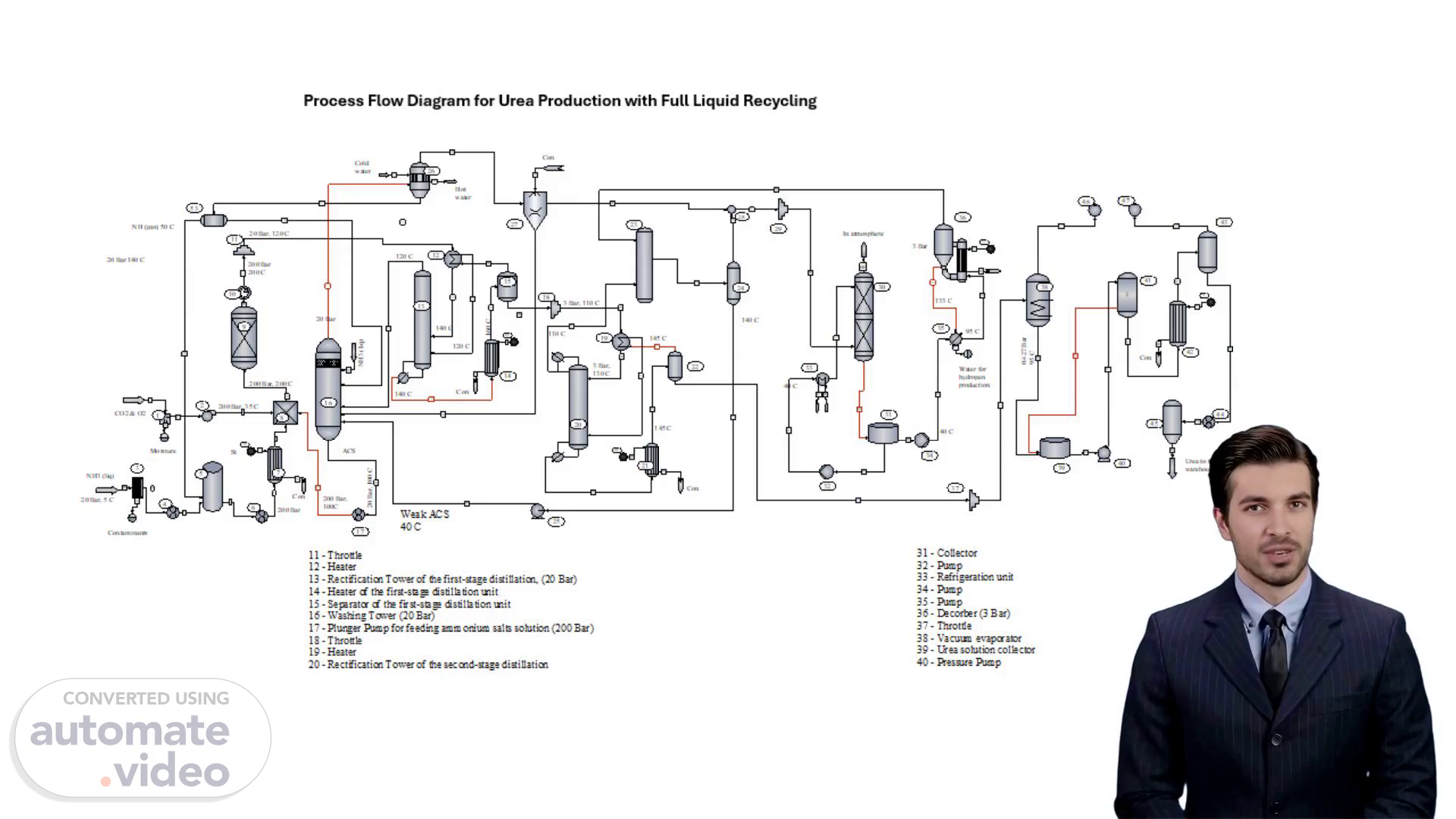
Process Flow Diagram for Urea Production with Full Liquid Recycling
Scene 1 (0s)
[Virtual Presenter] 1. The production of urea through full liquid recycling is presented. 2. The process involves mixing carbon dioxide with oxygen in an amount of 0.6-1 volume % to prevent corrosion of the apparatus. 3. Liquid ammonia is supplied to the liquid ammonia collector which also receives return liquid ammonia from the condenser. 4. From the collector liquid ammonia is pumped under pressure and temperature to the mixer where it is mixed with carbon dioxide and ammonia not converted into urea in the form of a solution of ammonium salts. 5. The mixer is designed to thoroughly mix all three components resulting in the formation of ammonium carbamate. The process in the mixer takes place at 180-200 degrees celsius and 200 bar. 6. From the mixer the melt enters the synthesis column in which urea is formed at 200 degrees celsius and 200 bar. The residence time (10) of the reaction mixture in the synthesis column is 45 minutes. Under these conditions the degree of conversion of ammonium carbamate to urea is 65%. 7. The urea melt formed in the synthesis column is throttled from 200 bar to 20 bar and sent to the first-stage distillation unit. 8. In the distillation unit the melt is heated to 140 degrees celsius by gases from the separator and the gases are cooled to 120 degrees celsius after transferring their heat to the melt. 9. The liquid phase from the distillation column goes to the heater in which the steam is heated to 160 degrees celsius. From the heater the vapor-liquid mixture enters the separator where the gas and liquid phases are separated. 10. The liquid phase from the separator enters the second-stage distillation unit consisting of a heater a rectification tower and a separator. 11. Pure gaseous ammonia from the washing column is condensed and discharged into the ammonia collector for return to the cycle. 12. The liquid phase after separation is throttled to a pressure of 3 bar and added to the second-stage distillation unit. 13. Finally the liquid phase is a 70-72% urea solution and is sent for processing into the finished product. 14. The process is made possible by the use of C-O-2 as a reactant and oxygen as a passivating agent. 15. The use of full liquid recycling reduces waste and makes the process more efficient..
Scene 2 (2m 59s)
[Audio] We examine the specific components and steps involved in the process of producing urea through full liquid recycling. Carbon dioxide enters the compressor and is mixed with oxygen to prevent corrosion. Liquid ammonia is supplied to the mixer to form ammonium carbamate which is then converted into urea in the synthesis column. The urea melt formed in the column is sent to the distillation unit where it is heated and cooled before the gases and liquid phases are separated. The resulting urea solution is a 70-72% urea solution..
Scene 3 (3m 38s)
[Audio] 1. Urea production is discussed through full liquid recycling. 2. The process begins with the Iloc reactor which is used to ensure autothermal synthesis by heating fuel and water. 3. Ammonium carbamate is formed in the mixer which is then sent to the synthesis column. 4. The resulting mixture is sent to the synthesis column where urea is formed at high temperature and pressure. 5. The urea melt is throttled and sent to the distillation unit where it is heated cooled and separated into its components. 6. The liquid phase from the distillation column is then sent to a second-stage distillation unit where excess ammonia is distilled off and ammonium carbamate is decomposed. 7. The final product is a 70-72% urea solution. 8. Recycling of gases is done to reduce waste..
Scene 4 (4m 35s)
[Audio] 70-72% urea solution is produced through full liquid recycling process. The process includes several stages: compression heating mixing synthesis distillation purification and recycling of gases. The first stage involves mixing carbon dioxide with oxygen to prevent corrosion followed by heating in the heater. The resulting ammonia carbon dioxide and firewood are supplied to the mixer which forms ammonium carbamate. The second stage involves synthesizing urea at high temperature and pressure in the synthesis column. The urea melt is then throttled and sent to the distillation unit where it is heated cooled and separated into its components. The liquid phase from the distillation column is then sent to a second-stage distillation unit where excess ammonia is distilled off and ammonium carbamate is decomposed. The final product is a 70-72% urea solution. The process also includes purification and recycling of gases to reduce waste. Gases are purified from ammonia before being released into the atmosphere using a system consisting of an Absorber and a Desorber. Unabsorbed gases with small admixtures of ammonia from the condensers of the first and second stages enter Absorber which is irrigated with steam. The weak solution of ammonia and ammonium salts formed in the absorber is then sent to Desorber where ammonia is separated from the solution and returned to the second-stage condenser. Water from the Desorber containing small impurities of ammonium carbonate is sent to reverse osmosis for purification. The purified water is then used in hydrogen production. Finally gases purified from ammonia are released from the absorber into the atmosphere. The liquid phase from the Second-stage Separator enters the Vacuum Evaporator where due to self-evaporation it condenses to 76%. Then in film-type Evaporators (42) and (43) the solution is evaporated to 98.5%. The melt is then sent to the Granulation tower and subsequently to packaging..